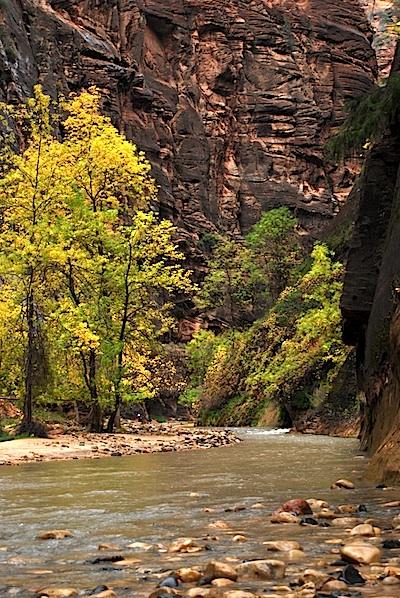
A management plan for the Virgin River and its tributaries in Zion National Park has been completed. Kurt Repanshek photo.
Zion National Park has completed a plan to guide management actions and visitor use on the Virgin River and its tributaries.
The plan was necessary as sections of the river in 2009 were added to the National Wild and Scenic River System. The Wild and Scenic River designation includes segments of the Virgin River, La Verkin Creek, Taylor Creek, and North Creek (including some tributaries) in Zion National Park and adjacent Bureau of Land Management wilderness.
The completed plan will provide a framework to guide future resource management and visitor use.
The plan provides protection for 144 miles of designated wild and scenic rivers within Zion National Park. The management and monitoring strategies found in the plan are designed to protect and enhance the rivers' free-flowing condition, water quality, and other values that qualify these river segments for inclusion in the National Wild and Scenic River System.
The management plan identifies:
* The kinds and amounts of visitor use that each river segment can accommodate while ensuring protection of river values;
* The types and levels of development allowed in each river corridor;
* Indicators that will be monitored to track changes caused by human activity;
* Adaptive management strategies to implement as changes occur;
* Actions to preserve the rivers free flowing condition; and
* Actions to protect and enhance water quality, ecological processes, scenic values, recreational opportunities, and fish and wildlife.
To read the details of the management plan, go to this page.



Comments
I didnt want to respond but I couldnt help but take your bait. Here you go EC- Genesis 1:26-28
Then God said, "Let Us make man in Our image, according to Our likeness; let them have dominion over the fish of the sea, over the birds of the air, and over the cattle, over all[a] the earth and over every creeping thing that creeps on the earth." 27 So God created man in His own image; in the image of God He created him; male and female He created them. 28 Then God blessed them, and God said to them, "Be fruitful and multiply; fill the earth and subdue it; have dominion over the fish of the sea, over the birds of the air, and over every living thing that moves on the earth."
This represents 19th century (and some current) environmental attitudes perfectly.
I know you dont see what I see when you read this. You and I will never change each others minds, so I do not see the point in engaging the president of the Glenn Beck fan club in further conversation.
Lets both get out and enjoy nature.
Beautiful photograph of Zion NP.
And Rambler, you seem to have failed to realize that man has moved species throughout the world, much to the betterment of man.
There may be a reason to save the delta smelt, if so I would love to hear it. Please enlighten me also to the dire consequences that would occur should the Virgin Spinedace be displaced by the Rainbow Trout.
Rambler - thanks for the documentation. But, as you can see, I don't subscribe to that notion that man can subdue earth, nor am I particular fan of Glenn Beck.
Now back to the Spinedace in Zion - what would be the dire scientific consequences of its demise in the Virgin River?
Agree about the picture Justin. In fact it was that picture that led me to the question. I saw that river and what appeared to be a beautiful spot to place a prince nymph. It prompted me to look up fishing opportunities in Zion and I was disappointed to find that fishing the Virgin is quite unproductive, primarily because of efforts to prevent expansion of sport fish such as the Rainbow and Brown trout. That led to the question, why? Still waiting for an answer beyond,(paraphrased) "Because the Spinedace exist".
Thanks Justin. Took that last October during a visit. It was an overcast day, but that didn't seem to hurt the final photo.
EC,
I wonder if anyone posed a similar question when quagga mussels showed up in the Great Lakes, or when the Ivory-billed woodpecker disappeared, or when the wolf was extirpated from Yellowstone. There always are consequences, though they might not always be apparent initially.
One possible consequence of creating rainbow trout fisheries as you would like could be anglers crowding the banks, or perhaps standing in mid-stream, of the Virgin River. That in turn could lead to unintended consequences -- bank erosion, litter, etc.
Speaking of quagga mussels, just received a release from Lake Powell (Glen Canyon NRA) that they've found "Thousands of adult quagga mussels" since lake levels dropped. That's a serious problem that will be hard to reverse. We'll have a story on it later today.
We've just heard another echo of the Great American Entitlement Mentality.